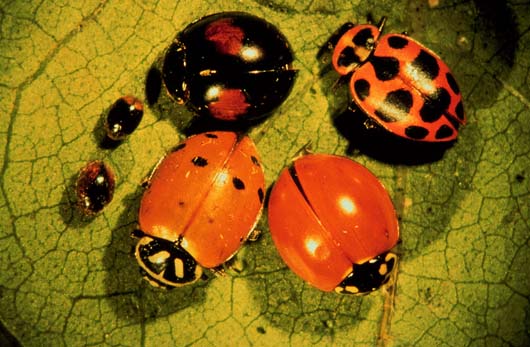Common names: Ladybird beetles, Ladybugs, Lady beetles, Coccinellid, Coccinellid beetles
Scientific names:
Harmonia conformis, H. axyridis, Hippodamia convegens
Coleoptera:Coccinellidae
Type
Generalist predators
Hosts
Aphids, leaffolders, leafhoppers, mealybugs, planthoppers, scales, spider mites, whiteflies, and other leaf feeding insects.
Description
Eggs are yellow to orange in color, football-shaped, and are laid in circular clusters of 10 -50 eggs on the underside
of leaves or near the aphid colony.
Newly hatched larvae are gray or black and less than 4 mm long. They emerge as dark alligator-like flightless creatures with orange spots. Adult larvae can be gray, black, or blue with bright yellow or orange markings on the body. They are usually patterned with colors similar to their parents, and many are adorned with spines. They have long sharp mandibles and feed on small insects like their adults. The larvae are elongate and slightly oblong in shape. They undergo four instars before pupating.
The pupae are usually brightly patterned and can be found attached to the leaves and stems of plants where larvae have fed and developed.
Adults are oval to hemispherical and strongly convex with short legs and antennae. Most species are brightly colored. Body length ranges from 0.8-16 mm. Their colors tell other predators that they are tasteless and toxic. When disturbed, some of them emit a strong smelling yellow liquid as a
protection against other predators. Their colors vary from red, orange, steel blue, yellow brown, or yellow
elytra, frequently spotted or striped with black. They feed on pollen, nectar, water, and honeydew but aphids or other prey are necessary for egg production. They are the best-known predators of aphids and are capable of eating up to 50-60 per day and about 5000 aphids in their lifetime.
Many species are well-known for their use in biological control, and have been distributed to various parts of the world to combat insect pests of agricultural crops. However, members of the subfamily Epilachninae are foliage feeders and are sometimes pests of several crops.
Conservation
Lady bird beetles are found in most agricultural and garden habitats.
Their presence indicates that natural biological control is occurring. It is important to maintain habitats planted with several flowering crops. These give the ladybird beetles varied food sources. When food is not available, they tend to eat each other. Their beneficial predatory behavior and activities are continuous when there is no indiscriminate use of synthetic pesticides.
External links
References
- Mason, P. Huber, J. Editors. (2002): Biological control programmes in Canada, 1981-2000. CABI Publishing. CAB International, Wallingford, UK.
- Olkowski, W.; Daar, S.; Olkowski, H. (1995): The gardener?s guide to common-sense pest control. The Taunton Press. USA.
- Scholaen, S. (1997): Manejo integral de plagas en hortalizas. GTZ Eschborn.
- Teetes, G.; Pendleton, B. (1999): Insect pests of sorghum. Department of Entomology. Texas A&M University.
- Yepsen, R. Editor. (1984): The encyclopedia of natural insect and disease control. Rodale Press, Emmaus, PA.

